|
|
 |
|
Cyclopoida ( Order ) |
|
|
|
Oncaeidae ( Family ) |
|
|
|
Epicalymma ( Genus ) |
|
|
| |
Epicalymma exigua (Farran, 1908) (F,M) | |
| | | | | | | Syn.: | Oncaea exigua Farran, 1908 b (p.93, Descr.F, figs.F); Rose, 1933 a (p.301, figs.F); Sewell, 1948 (p.483); Pavlova, 1966 (p.45); Razouls, 1972 (p.95, Annexe: p.117, figs.F); 1974 b (p.241, figs.F); Gordejeva, 1975 a (p.778, Descr. M, figs.F,M); Kovalev & Shmeleva, 1982 (p.86); Malt, 1982 (p.193); 1983 a (n°169-171, p.7, 9) ; Greze & al., 1985 (p.8); Khelifi-Touhami & al., 2007 (p.327, Table 1); | | | | Ref.: | | | Heron & al., 1984 (p.479, 485, figs.F,M, Rem.); Krsinic, 1998 (p.1051); Bradford-Grieve & al., 1999 (p.887, 970, figs.F,M); Heron & Frost, 2000 (p.1057, tab.2, 3); Böttger-Schnack & Schnack, 2009 (p.131, Table 5: Rem.); Böttger-Schnack & Schnack, 2013 (p.4: Table 1) | 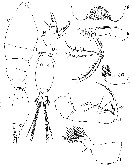 issued from : G.A. Heron, T.S. English & D.M. Damkaer in J. Crustacean Biol., 1984, 4 (3). [p.486, Fig.19, C-J]. Female (from Arctic): C, habitus (lateral; scale bar: w); D, posterior of last prosomal segment and urosome (dorsal; scale bar: w); E, right A2 (scale bar: z); F, labrum (ventral; scale bar: x); G, right Md (scale bar: x); H, left Mx1 (scale bar: x); I, left Mx2 (scale bar: x); J, left Mxp (scale bar: x). Nota : Exoskeleton thinly clerotized. Prosome about 1.4 times as long as urosome. Genital segment with areas external genital apparatus midway on anterior half of dorsal surface, each area with minute setule.. Two short postgenital segments frequently telescopod partially or completely. Anal segment with operculum margin distended posteriorly as lapet. Caudal ramus with conspicuous expansion on dorsal surface, surrounding base of dorsal seta ; dorsal seta nearly as long as inner an douter terminal setae, all resilient.. P5 represented by 1 pedicellate seta on posterolateral corner of 1st urosomal segment ; lateral seta on body near that corner. P6 probably represented by minute, blunt setule scarcely extending below genital operculum.
|
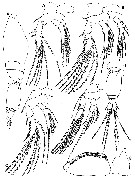 issued from : G.A. Heron, T.S. English & D.M. Damkaer in J. Crustacean Biol., 1984, 4 (3). [p.487, Fig.20]. Female: A-D, P1 to P4 (scale bar: z). Male: E, habitus (lateral; w); F, posterior of last prosomal segment and urosome (dorsal; scale bar: w); G, left Mxp (scale bar: x); H, endopod of P1 (scale bar: z). Nota : Prosome about 1.9 times as long as urosome. Anal segment and caudal ramus resembling that of female. Rostral area and mouthparts, except A1 and Mxp, as in female. A1 with armature similar to correspoding segments of female, except for absence of distal seta on 3rd segment. Mxp with 2nd segment expanded, with inner longitudinal cleft ; posterior expansion rimmed with several rows of setules. Swimming legs and P5 as in female, except endopod of P1 with terminal spine and distal seta modified. P6 probably represented by rounded posterolateral flap with hyaline corner on ventral surface of genital segment ; armature not discerned.
|
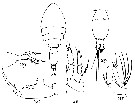 issued from : G.P. Farran in Fish. Ire. Sci. Invest., 1906, II [1908]. [Pl. X, Figs.25-30]. As Oncaea exigua. Female (from 54°50'- 57'N, 10°30'-51'W): 25, urosome (dorsal); ; 26, habitus (dorsal); 27, A2; 28, P4; 29, Mx2.; 30, Mxp.
|
 issued from : G.P. Farran in Fish. Ire. Sci. Invest., 1906, II [1908]. [Pl. XI, Figs.9-11]. As Oncaea exigua. Female: 9, P2; 10, P1; 11, P3.
|
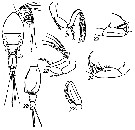 issued from : K.T. Gordejeva in Zool. Zh., 1975, 54 (5). [p.777, Figs.21-27]. As Oncaea exigua. Female (from Atlantic tropical, 15-20°W): 21, A2; 22, Mx2; 23, A2; 24, Mx2. Male: 25, habitus (dorsal); 26, urosome (lateral); 27, Mx2.
|
 issued from : C. Razouls in Th. Doc. Etat Fac. Sc. Paris VI, 1972, Annexe. [Fig.80]. As Oncaea exigua. Female (from Banyuls, G. of Lion): A, urosome; B, A2; C, P4; D-E, Mxp; F, P2; G, P1; H, P3.
| | | | | Compl. Ref.: | | | Uysal & al., 2002 (p.18, tab.1); Krsinic & Grbec, 2002 (p.127, tab.1) | | | | NZ: | 5 | | |
|
Distribution map of Epicalymma exigua by geographical zones
|
| | | | | |  Chart of 1996 Chart of 1996 | |
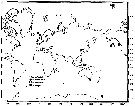 issued from : G.A. Heron & B.W. Frost in Proc. Biol. Soc. Washington, 2000, 113 (4). [p.1061, Fig.25]. issued from : G.A. Heron & B.W. Frost in Proc. Biol. Soc. Washington, 2000, 113 (4). [p.1061, Fig.25].
Locality records for selected species of Epicalymma.
Records include previously published personal observations and data presented in this study (p.1023, Table 3) |
| | | | Loc: | | | Atlant. (E tropical), off NW Ireland, Mer de Norwegian Sea, Arct. (Canadian Basin), Ibero-moroccan Bay, Medit. (Alboran Sea, Gulf of Annaba, Banyuls, S Adriatic Sea, Aegean Sea, Lebanon basin), NE Pacif., Washington inland. | | | | N: | 10 | | | | Lg.: | | | (24) F: 0,52-0,48; (675) F: 0,56-0,44; M: 0,48-0,42; (682) M: 0,55-0,3; (848) F: 0,43-0,48; M: 0,39-0,41; {F: 0,43-0,56; M: 0,30-0,55} | | | | Rem.: | Mesopelagic.
Characteristics after G.A. Heron & B.W. Frost (in Proc. Biol. Soc. Washington, 2000, 113 (4), p.1058): Female: Genital segment with gonopore located on anterior third of dorsal surface. Anal segment with operculum margin medially distended. Male: Anal segment with operculum margin medially distended. For Heron & al. (1984, p.488) The female resembles E. brittoni but differs from it by a more delicate appearance, the longer seta representing P5, and the comparatively narrow, serrate, hyaline flange on swimming leg spines. Farran's description and illustrations of O. exigua coincide so closely with two similar Arctic species that it was difficult to determine which species he had described. | | | Last update : 02/12/2016 | |
|
|
 Any use of this site for a publication will be mentioned with the following reference : Any use of this site for a publication will be mentioned with the following reference :
Razouls C., Desreumaux N., Kouwenberg J. and de Bovée F., 2005-2025. - Biodiversity of Marine Planktonic Copepods (morphology, geographical distribution and biological data). Sorbonne University, CNRS. Available at http://copepodes.obs-banyuls.fr/en [Accessed July 03, 2025] © copyright 2005-2025 Sorbonne University, CNRS
|
|
 |
 |










